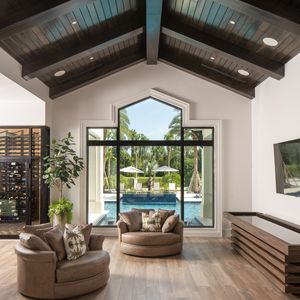Few things are as satisfying as curling up with a good book on a chilly day, but leave it to TikTok to make this time-honored activity even better with its latest design trend, the reading corner. Situated perfectly at the intersection of the #cozyaesthetic and #BookTok, a megatrend with over 84.5 billion views, a reading corner (or reading nook) is now the new must-have design feature of 2022. And while not all online trends translate well into real life, this is one that certainly does.
Why Reading Corners Are Seeing a Surge in Popularity Now
At its heart, a reading corner is simply an area dedicated to being the perfect spot to read. A quiet place to unplug is the perfect antidote for today’s fast passed and ultra-connected lifestyle, and making a space in your home that acts as a refuge from the world is a sensible style choice.
It’s not just internet influencers who are setting up reading areas, either. Alex Kaehler of Alexandra Kaehler Designs confirms that she’s also seeing an increase in requests for book corners; their popularity reflects the way we live now. “My clients are generally spending a lot more time at home, and as such want nooks to ‘retreat,’” Kaehler says. “Not everyone has a room where they can go to escape, so creating a dedicated spot for reading is ideal.”
:max_bytes(150000):strip_icc():format(webp)/bhg-reading-corner-chair-windows-6826293-05ce3785cd394b7d9648700a8de4cc81.jpg)
Many people are still working from home at least a few days a week (if not more), as well, and with all the additional hours spent in our houses and home offices, at some point, we’ll all likely want to change things up design-wise. This may be another reason reading corners are trending: They’re a quick and easy way to do a room refresh without a major overhaul. You may be able to create a reading area just by repurposing pieces you already own, so this is a perfect time- and budget-friendly DIY project if you can’t invest in new furniture or devote weeks to renovating.
A reading corner is also the rare trend that works for just about everyone. In addition to being inexpensive, these nooks fit into homes large and small, and within all styles of decor. Any unused spot can be transformed into a reading corner with a little effort. In fact, a reading nook can be an excellent solution for giving an awkward, unused corner style and purpose.
How to Create the Perfect Reading Corner
While it might feel a little indulgent to create a space dedicated just to reading, that’s part of the pleasure of a reading corner. Having a special nook elevates the experience and gives your leisure time an element of self-care. With just a few small changes, you can establish an area that feels like it’s worlds apart from the hustle and bustle of everyday life and allows you to relax and recharge. Depending on your style, there are endless options for adding a reading corner to your home, but here are a few ideas to get you started and inspire you to set up your perfect reading refuge.
:max_bytes(150000):strip_icc():format(webp)/bhg-window-seat-green-built-ins-102023365-b7cd531c42904145b79f28c14366ac76.jpg)
Naturally, the most important item for a reading nook is a comfy place to sit; whether that’s a chair or the well-padded bench of a window seat, you need a spot you can lounge for hours.
“Wherever we put a cozy chair, we try to add a side table to put a drink or a book and a lamp to have additional lighting,” Kaehler says. “If you have the space, adding in an ottoman is a really nice touch, and that makes it even more comfortable to spend time in the chair!”
To make sure your reading corner has all the basics, consider adding a shelf or bookcase where you can store some of your latest reads and old favorites, so you always have plenty of books at hand.
Once the basics are covered, add details that let your style shine. These little touches are what make your space unique, so let your imagination run wild—a small space like a reading nook is the perfect location to experiment with bold style, like peel-and-stick wallpaper or extravagant floor coverings. You could even go a little kitschy and add a nod to your favorite book genre—perhaps a magnifying glass for a mystery lover or a floral print for a budding botanist. As long as you love it, anything goes!
Finally, consider ways to involve different senses to enhance your reading experience. The warm glow of candles or a diffuser with essential oils can set the tone for a quiet evening at home, or a special cup of tea can signal it’s time to wind down. Add a soft throw blanket as a finishing touch, and you’ll be all set for a wonderful reading experience.

 Facebook
Facebook
 X
X
 Pinterest
Pinterest
 Copy Link
Copy Link



:max_bytes(150000):strip_icc():format(webp)/dark-kitchen-marble-island-clear-glass-cabinets-2XMKNPuWq-v8VFxFMqYuay-a32514292f414f36a995d57634c5a809.jpg)
:max_bytes(150000):strip_icc():format(webp)/haven-design-dark-kitchen-6fbc459e7dbe408c8d557c5c8877517c.jpg)
:max_bytes(150000):strip_icc():format(webp)/dark-kitchen-island-barstools-fcece6d7-327a8762b8394992a2ddf58b001a3159.jpg)
:max_bytes(150000):strip_icc():format(webp)/brown-leather-stools-dark-kitchen-0qwrjiyA4Vj9MHdrj6Xh8J-2-337b7f6d00c7483fab0444b203042c72.jpg)
:max_bytes(150000):strip_icc():format(webp)/kitchen-dark-green-cabinets-farmhouse-sink-2c4ZbGdVKrxBrxNpM6G1Vr-9dc4403335e64e7891bc8db90ed58b0e.jpg)
:max_bytes(150000):strip_icc():format(webp)/nu-interiors-kitchen-96f1d3c9870348959d6d46894eb426f1.jpg)
:max_bytes(150000):strip_icc():format(webp)/blue-kitchen-cabinets-dark-wood-counters-DrzuBawa4BdBdIU6kCjiTK-6ed6c4a92508427bba4831a516f92ad2.jpg)
:max_bytes(150000):strip_icc():format(webp)/el-design-studio-gray-kitchen-cabinets-15cb545827504c7993fdceb89dc8c500.jpg)
:max_bytes(150000):strip_icc():format(webp)/el-design-studio-kitchen-9915d8d73ec64c17afc2f3524bb76b14.jpg)












